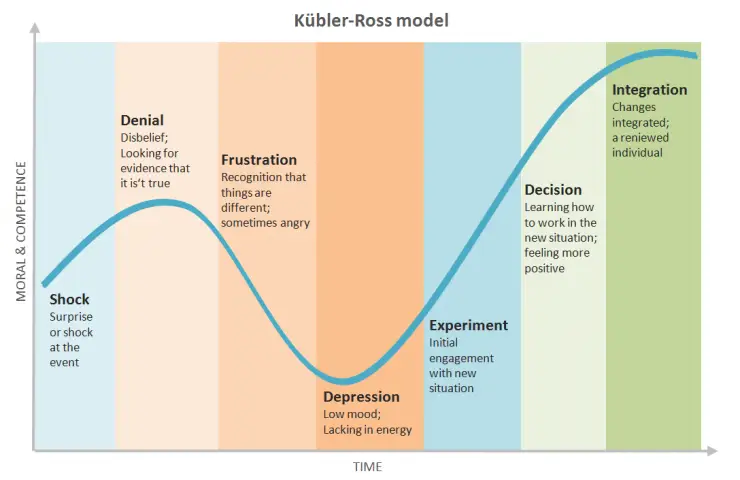Explaining Change
The Change Curve
With every distracting event, let it be the introduction of new technology or an outbreak that forces all employees to work from home, as proposed by Kubler-Ross in her book “Death and Dying” employees will go through similar stages like those described on the curve below. The curve is known as the Kubler-Ross Change curve or also known as the 5 stages of grief. The curve reflects the stages individuals go through when any change event occurs. The 5 stages included in the model are denial, anger, bargaining, depression and acceptance.

Kübler-Ross Model*
The model has been used to explain changes in different applications including business.
Stage 1: The first stage after any sudden change is usually shock and denial. At this point, employees are not able to accept the fact that they need to adapt to something new. Employees feel that they are rejecting the current situation and need time to deal with it. As a manager or employer, the role is to help employees understand the current situation and the causes behind it. Full communication and transparency is needed so employees can have a clear understanding of the situation. However, employers must deliver the information to employees gradually without overwhelming them with too much detail at once.
Stage 2: When the situation finally settles in and reality becomes clear, employees will begin to feel that they are outside their comfort zones and need to learn and adapt. This shock creates a feeling of anger and resentment. In order to avoid chaos, mangers need to deal with the emotions of their employees very sensibly through careful pre-planning. Clear communication and support should be a priority for organizations. Managers need to accept that this is a natural reaction and with time employees will settle and accept the change.
Stage 3: Employees at this stage have a deeper understanding and acceptance of the new situation. Employees will try to bargain with management so they can compromise less than required.
Management needs to be prepared with a determined plan to ensure that everyone gets and gives the best during this transition. Training should be given to employees to equip them with the skills needed for the new circumstances. The training stage may take some time as a company cannot rush employees to learn quickly or adapt fast to changes.
Stage 4: This stage is known as the learning phase, this phase may not be very exciting for most employees especially those who do not enjoy learning. Management needs to introduce new and creative ways to encourage the learning of their employees for example through the introduction of new virtual training tools or through team building events that allow more collaboration and interaction among employees.
Stage 5: This is the stage managers wait for since the eruption of the change. People finally embrace the change, accept the situation and start building new hopes and aspirations. Managers will begin to reap the fruits of their hard work. Teams start to show improvements and overall productivity increases. Employees are finally integrated once again and are working positively and actively towards the future.
In conclusion, the Kubler Ross change curve identifies the several emotional stages employees go through as a response to any change. Through the understanding of the curve managers can manage and influence the emotions of their employees to guide them towards organizational change.
*https://www.cleverism.com/understanding-kubler-ross-change-curve/
For more about this topic, download our latest book "Reality of the World Today" for FREE:
